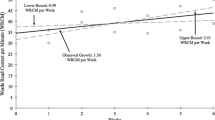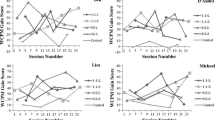Abstract
Adapted alternating treatments designs were used to evaluate three computer-based flashcard reading interventions (1-s, 3-s, or 5-s response intervals) across two students with disabilities. When learning was plotted with cumulative instructional sessions on the horizontal axis, the session-series graphs suggest that the interventions were similarly effective. When the same data were plotted as a function of cumulative instructional seconds, time-series graphs suggest that the 1-s intervention caused the most rapid learning for one student. Discussion focuses on applied implications of comparative effectiveness studies and why measures of cumulative instructional time are needed to identify the most effective intervention(s).
-
Comparative effectiveness studies may not identify the intervention which causes the most rapid learning.
-
Session-series repeated measures are not the same as time-series repeated measures.
-
Measuring the time students spend in each intervention (i.e., cumulative instructional seconds) allows practitioners to identify interventions that enhance learning most rapidly.
-
Student time spent working under interventions is critical for drawing applied conclusions.


Similar content being viewed by others

References
Hopkins, M. B., Hilton, A. N., & Skinner, C. H. (2011). Implementation guidelines: how to design a computer-based sight-word reading system using microsoft® PowerPoint®. Journal of Evidence-Based Practices in the Schools, 12, 219–222.
Poncy, B. C., Solomon, G. E., Duhon, G. J., Skinner, C. H., Moore, K., & Simons, S. (2015). An analysis of learning rate and curricular scope: caution when choosing academic interventions based on aggregated outcomes. School Psychology Review, 44, 289–305.
Pro-ed. (2011). Edmark Reading Program Family of Products. Retrieved from http://www.proedinc.com/customer/ProductView.aspx?ID=4842.
Skinner, C. H. (2008). Theoretical and applied implications of precisely measuring learning rates. School Psychology Review, 37, 309–315.
Skinner, C. H. (2010). Applied comparative effectiveness researchers must measure learning rates: a commentary on efficiency articles. Psychology in the Schools, 47, 166–172. doi:10.1002/pits.20461.
Skinner, C. H., Belfiore, P. B., & Watson, T. S. (1995/2002). Assessing the relative effects of interventions in students with mild disabilities: Assessing instructional time. Assessment in Rehabilitation and Exceptionality, 2, 207-220. Reprinted (2002) in Journal of Psychoeducational Assessment, 20, 345-356.
Yaw, J., Skinner, C. H., Maurer, K., Skinner, A. L., Cihak, D., Wilhoit, B., Delisle, J., & Booher, J. (2014). Measurement scale influences in the evaluation of sight-word reading interventions. Journal of Applied Behavior Analysis, 47, 360–379. doi:10.1002/jaba.126.
Acknowledgments
This study was completed with support from the Korn Learning, Assessments, and Social Skills Center at the University of Tennessee.
Author information
Authors and Affiliations
Corresponding author
Ethics declarations
Each author declares that he/she has no conflict of interest. All procedures performed in studies involving human participants were in accordance with the ethical standards of the institutional and/or national research committee and with the 1964 Helsinki Declaration and its later amendments or comparable ethical standards. Informed consent was obtained from all individual participants included in the study.
Rights and permissions
About this article
Cite this article
Black, M.P., Skinner, C.H., Forbes, B.E. et al. Cumulative Instructional Time and Relative Effectiveness Conclusions: Extending Research on Response Intervals, Learning, and Measurement Scale. Behav Analysis Practice 9, 58–62 (2016). https://doi.org/10.1007/s40617-016-0114-3
Published:
Issue Date:
DOI: https://doi.org/10.1007/s40617-016-0114-3



